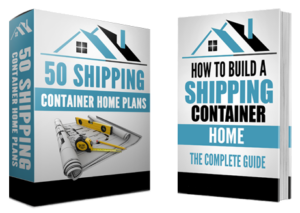Our Container Home Cost Calculator is a quick, easy way to get an estimated cost for your container home. This calculator is based on a Factored Construction Estimate, one of the three types of construction estimating techniques we cover in our in-depth article on the Costs of Shipping Container Homes. If you haven’t already, we recommend reading that article to get up to speed.
Curious about how the calculator works? Scroll down or click here. Otherwise, let’s check it out!
The Container Cost Calculator
The calculator will appear just below this paragraph (you may have to wait a few seconds for it to load). If you aren’t sure which options to select, scroll down or click here to be taken to the detailed input descriptions.
How the Cost Calculator Works
The calculator starts with a base estimate for the cost of building a one-TEU container home as a DIY project. It’s a cost we’ve provided as a Rough Order of Magnitude (ROM) estimate based on our experience with container homes, as discussed in this article on cost estimating.
As you select the various inputs or factors in the cost calculator, each one will slightly increase or decrease the estimated cost. When you hit the ‘Calculate’ button, our algorithm combines all the factors and calculates the overall estimated cost of the project, instantly and for free!
In addition, the calculator also creates the following results:
- The Gross Square Footage (GSF): Gross square footage is the overall exterior size of the home based on the number of TEUs. Writing ‘gross’ means that the floor area that’s in between the walls is also counted. Other measures you may see, like ‘net’, only include usable square footage in rooms, for example.
- The Estimated Cost per GSF: A common metric in construction science and real estate is the cost per square foot. It allows you to easily compare different types of buildings. Houses in the same area, built in similar ways, even if they are differently sized, often have similar costs per square foot.
- The ± 25% Accuracy Range: This factored estimate, like all estimates, is imperfect. We recommend that you consider the strong possibility the actual cost could be anywhere in the range of 25% below or above the estimated cost due to unknowns. In certain extreme situations, you may even have a cost that falls outside of the range.
- The ROM Estimate: As explained above, this factored estimate is based in part on a ROM estimate. We provide you the ROM estimate, which itself is based on the number of TEUs in your design and our judgment of the base cost of a container home on a TEU basis.
The calculator has eight simple fields to fill out, seven of which are multiple-choice and one of which is a number of TEUs. We’ve intentionally made it simple so it’s fast and easy to use!
However, because of this simplicity, it does have some caveats. For instance, the calculator doesn’t account for the costs of things like land or furnishings.
Descriptions of each Input in the Cost Calculator
Below is a detailed description of each form field in the cost calculator above. If you’re not sure which option to select, the descriptions below will help you choose.
Number of TEUs
Just like with the ROM estimate, the principal driver of cost in the factored estimate is the size of your container home. Additionally, size also affects economies of scale – the larger your home, the less it costs on a per-TEU basis. This is a separate factor in our algorithm that improves accuracy.
The size is based on Twenty-foot Equivalent Units (TEUs), the basic measuring block in the shipping container industry. As you may have learned in our dimensions article, a TEU represents a 20ft by 8ft horizontal area. Below are the equivalent sizes in TEU of some containers often used in shipping container construction:
- A 40ft container would be 2 TEUs
- A 45ft container would be 2.25 TEUs
- A 48ft container would be 2.4 TEUs
- A 53ft container would be 2.65 TEUs
Note that the height of the container (typically a choice between the standard height of 8.5ft vs ‘high-cube’ at 9.5ft) doesn’t affect its size in TEUs. Containers with slightly increased widths (like pallet-wide containers and 53ft containers) are assumed to be only 8ft wide for purposes of calculating equivalent TEUs.
Responsible Party
One of the biggest decisions you make (and most impactful of cost) is whether to build your container home yourself or not. Hiring a contractor adds substantial cost to the project versus doing it yourself, as the calculator will quickly show. However, if you don’t think you have the time, energy, or experience to do it yourself, a builder can be invaluably helpful in achieving your dream.
Location Considerations
Where you build your container has a large impact on the cost, demonstrated in two ways. First are the costs of goods and services in your general area. You probably already know if where you live is considered a high cost of living (HCOL) or low cost of living (LCOL) location.
If you’ve never heard about your area being either high or low cost, you’re probably about average. You can also check out resources like Numbeo, Nomadlist, and Expatistan for the cost of living data for cities and countries around the world.
The second way location affects cost is the specific location of your building site. For instance, if you’re in a generally low cost of living area, but one of the following statements is true, you should consider adjusting this factor upwards.
- Building in an undeveloped area that is difficult to access without special equipment (four-wheel drive trucks, snow-capable vehicles, high-clearance vehicles, etc.)
- Building in a remote area that requires long travel times between the nearest major population center and the building site
- Building in a rural area that doesn’t have the particular building expertise needed in the local labor force
Climate
A crucial part of making a container livable is climate control. Due to their metal skin, containers are especially sensitive to temperature differences and need adequate insulation added to private the migration of heat energy. This is even more true for those that live in areas that are hot (tropical) or cold for a large part of the year.
Necessary Approvals
Regulating bodies (often local government, but sometimes other entities as well) can sometimes impose fees and require permits/submissions before yielding permission to build. This is typically in the form of a building permit, an inspection, a use-fee, etc. In some rural areas or low-regulation locations, there are effectively no requirements at all. In other areas, you may have a number of them to deal with.
The costs come not just from the actual fees themselves, but also from the impacts of preparing (and often, later modifying) your submissions in order to prove compliance with regulations. Oftentimes, this may require the input and guidance of a professional.
Site Complexity
The complexity of your site affects the project cost in ways you may not have considered. A flat field of grass is probably the cheapest option.
But if your site requires tree removal, difficult road construction, complex foundation work, etc. then the costs can increase.
Design Efficiency & Complexity
A design’s efficiency is a measure of how well it uses containers to produce living space. Assuming you won’t have curved walls, the most efficient space is a square followed by a cube. Therefore, a house that has more ‘arms’ spreading outward instead of having most of the space centralized will be less efficient (and more expensive).
The complexity of a design is somewhat related. Complexity is represented by how much cutting, stacking, joining, bridging, and cantilevering is called for in the design. These elements make for a unique and livable home, but also add to the cost.
Essentially, the more irregular the design (how far removed it is from a simple rectangular shape), the more costly.
Build Quality
Everyone knows a ‘fancy’ home when they see it: high-end materials, quality craftsmanship, and small extra details can really make a container home (or any home) shine. The choice of whether to build a ‘no-frills’ home or a house with a touch of luxury is yours to make, but it can cost you.
Takeaways
We hope this factored estimate calculator is useful as you decide about your future with container homes. With just a few mouse clicks, you should have a pretty good idea of what to expect your home to cost.
Remember that the calculator has limited inputs and is certainly not 100% accurate. If you’re looking for a more precise estimate, we recommend reading about bottom-up estimates.


